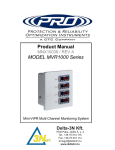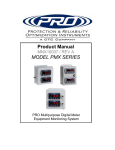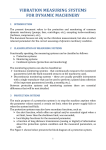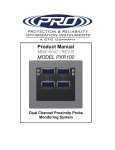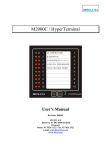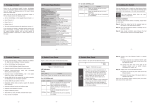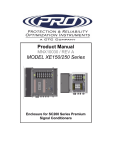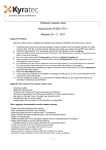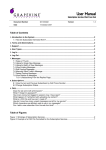Download MNX10023C-ViPR Installation Manual
Transcript
Product Manual MNX10023 / REV C MODEL VPR100 Series ViPR Multi Channel Monitoring System Contents Section I Overview Introduction.................................................................................….… 2 Description.......................................................................................... 2 ViPR Model Selection......................................................................... 2 Section II Installation Installation……………………………………………..…..........……...… 3 Configuring Relays............................................................................. 4 Analog Output..................................................................................... 5 Section III Operation Operating Procedure.......................................................................... 4 Section IV Maintenance General............................................................................................... 6 Warranty........................................................................................... 10 Figures Figure 1 (VP Series Selection Guide)…............................................. 2 Figure 2 (Cable Entry/Exit & Power)…………….…….........….……… 3 Figure 3 (Panel Cover)……….….……………………..........…….……. 6 Figure 4 (Wiring Diagram)……….….……………….......…....…..……. 7 Figure 5 (Main Panel)……….….…………………….............…..…….. 7 Figure 6 (Signal Conditioners)……….….…………….........………….. 8 Figure 7 (Connector Block Removal)…………………..….......………. 8 Figure 8 (Block Connections)…………………………….........……….. 9 MNX10023 / Rev C 4-11-08 1 Section I Overview Introduction This document contains information on the operation, installation and maintenance of the VPR100 Series Multi Channel Monitoring System. This manual is an overview of the system and references the specific component manuals. User manuals are provided with the system for all configurable internal components. Description The PRO VPR100 Series system monitors a machine’s condition based on its level of vibration. The system can be integrated into a circuit to shutdown a machine when preset vibration levels are reached. The system detects high vibration energy being sensed by the input accelerometers and actuates relays based on alert and alarm set points. The system will indicate the instantaneous vibration levels and relay status at each channel through the display meters. A 420mA signal analogous to the percent of full scale vibration (based on the internal transmitters) is provided as an output for external DCS interfacing. The system also supplies outputs for Dynamic Vibration data (Waveforms) transmitted by the accelerometers. The waveforms are obtained from the BNC jacks inside the enclosure, or can be wired from screw terminals identified by “Sensor Output”. ViPR Model Selection The VPR100 Series system has numerous options available to customize the ViPR system to specific needs. Below is a guide to help select which VP Series system fits your specific requirements. (Figure 1) Figure 1. VP Series Selection Guide MNX10023 / Rev C 4-11-08 2 Section II Installation The VPR100 Series system is contained within a standard fiberglass junction box enclosure. Mounting brackets are provided for wall-mounting the enclosure. (Wall anchoring screws are not included). Cables enter and exit the enclosure through conduit fittings on the bottom of the unit. All input and output wiring is connected at the terminal blocks at the bottom of the unit. All outputs are routed through a 1.5” Conduit Fittings. All inputs are routed through a 1.5” Conduit fitting as well. 110 VAC is needed to power the unit through the terminals on the far right side of the enclosure. A ½” Conduit Fitting is provided for AC power entry. (Figure 2) NOTE: If there is no sensor wired to the sensor input terminal, the corresponding transmitter for that channel will not power on. This will cause the Output Display to read low or negative values. Be sure to power the system on AFTER the sensor has been connected. NOTE: If the display fails to output a value after power has been turned on and the sensor has been wired, turn off the unit, wait several seconds and then reapply power. The internal electronics require some time to ramp up and settle before they are fully operational. Waveform Outputs Vibration Level Displays 110 VAC Power Sensor Inputs Relay Outputs Figure 2. Cable Entry/Exit &Power MNX10023 / Rev C 4-11-08 3 Section III Operation Configuring Relays The input to the internal controller comes from the signal conditioners. They are built with a specific full scale range and frequency band. The Full scale range of the transmitters must be known in order for the controllers to display the correct vibration value. The transmitter will not display any vibration energy present at frequencies outside the filtering range. Refer to PRO SC Transmitter User Manual for specific instructions on calibration and operation. Example Æ Full Scale 0 – 1.0 IPS , Frequency Band 10 – 1000 Hz. At 0 IPS, 4 mA flows from the transmitter to the controller At 0.50 IPS, 12 mA flows from the transmitter to the controller. At 1.00 IPS, 20 mA flows from the transmitter to the controller. The monitoring channel provides 2 relay outputs. The system comes from the factory with a specific vibration range in IPS, mm/s or g’s. To configure the relay set points, this range must be known. It is recommended that baseline and typical alarm values of vibration are also known before setup is attempted. The relays provided by the internal controller are highly configurable. Refer to PD765 User Manual for detailed programming instructions. All of the following parameters can be adjusted: • Relay Action – Automatic, Latching, Auto + Manual Reset, Latch with Clear. • Relay Operation – Set and Reset points (Hysteresis), On and Off time Delays MNX10023 / Rev C 4-11-08 4 Example Setup 1: A full scale range of 0 – 1 IPS has been specified. Baseline Vibration on the machine to be monitored is 0.18 IPS-pk. Alarm and Shutdown levels of vibration are specified as 0.35 IPS-pk and 0.65 IPS-pk respectively, reset points are specified as 0.30 IPS-pk and 0.60 IPS-pk. Using the provided PD765 Process Controller Manual; Select relay operation and action desired, for this example we will have LOC, Latching Operation with Clear relays. Then program “Set 1” as 0.35 and “Set 2” as 0.65, then program reset points, “rST 1” as 0.30 and “rST 2” as 0.60. After relays have been programmed, scaling must be set. For this example, we will use a 0-5 Volt input with a 0-1 IPS display. Program “inP1” as 0.00, then “diS1” as 0.00, then “inP2” as 5.00, then “diS2” as 1.00. This will let us have an input of 0.00 Volts, display of 0.00 IPS and at an input of 5 Volts, 1.00 IPS will be displayed by the meter. The system will now actuate the LOC Relay (Relay 1) when the vibration level reaches 0.35 IPS-pk and another LOC Relay (Relay 2) when the vibration level reaches 0.65 IPS-pk. In order to reset the LOC relays, the vibration level must fall below the reset point of 0.60, then press the ACK for relay 2 and once the vibration level falls below 0.30, press the ACK to reset relay 1. Analog Output The analog 4-20 mA signal represents the amount of vibration energy present at each channel based on the internal transmitter’s full scale. I.E. a 12 mA signal from a 0 Æ 2.0 IPS transmitter represents a vibration level of 1.0 IPS. The 4-20mA signal is wired to the terminal blocks labeled ‘4-20’. The terminal block marking strip identifies the individual polarity of the terminals. Each channel provides an analog output in order to interface with an external control or indicator. The 4-20mA signal is compatible with most PLC Analog Input Modules. Manual adjustment of the internal transmitters may be needed upon installation. Refer to PRO SC Transmitter user manual for specific instructions. MNX10023 / Rev C 4-11-08 5 Section IV Maintenance Once the system has been calibrated and installed it requires minimal maintenance. Basic checks to ensure system integrity should be made periodically. Visual Inspections should include examinations for the following: • The displays are operational • No visible electrical burns or smoke inside the enclosure • Enclosure hinges are free from rust and securely latched • No moisture or condensation build up inside the enclosure • Enclosure viewing window is clean and internal components are clearly visible This worksheet illustrates the method of removing the Main Display Panel to access the SC200 series signal conditioners 1. Start by removing the lower screw terminal block cover panel and let it hang by the tether cables. Figure3. Panel Cover MNX10023 / Rev C 4-11-08 6 2. This illustration shows the screw terminal panel suspended by the tether cables and the location of the wiring diagrams. Figure 4. Wiring Diagram 3. After the Screw Terminal panel has been removed, the Main Panel needs to come out. Start by removing the (4) Phillips head screws holding the main panel. Figure 5. Main Panel MNX10023 / Rev C 4-11-08 7 4. When the panel is dropped down and suspended by the tether cables, the SC200 series signal conditioners are now accessible. Figure 6. Signal Conditioners 5. Using a “Flat Blade” screwdriver, remove the lower connector block from the main unit. Figure 7. Connector Block Removal MNX10023 / Rev C 4-11-08 8 Figure 7. continued The block should have the Numbers 1-4on it. (shown right) For the Dynamic output, connect the wires to Terminals 3 & 4: • Terminal 3 – Positive output • Terminal 4 – Negative output Figure 8. Block Connections After wiring terminal blocks, re-insert them into the SC200 unit. Replace the main panel, use care when replacing the panel to prevent damage to the internal wiring harnesses. Warranty If any PRO product should ever fail, we will repair or replace it at no charge, as long as the product was not subjected to misuse, natural disasters, improper installation or modification which caused the defect. CONTACT INFORMATION: Connection Technology Center, Inc (CTC) 7939 Rae Blvd. Victor, NY 14564 1-800-999-5290 (US & Canada) 1-585-924-5900 (International) [email protected] – www.ctconline.com MNX10023 / Rev C 4-11-08 9











